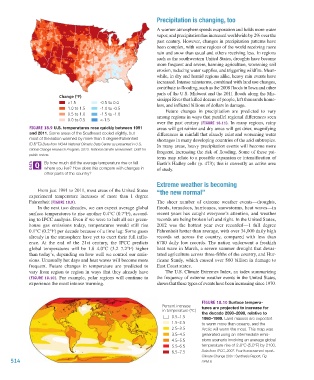Page 515 - Environment: The Science Behind the Stories
P. 515
Precipitation is changing, too
A warmer atmosphere speeds evaporation and holds more water
vapor, and precipitation has increased worldwide by 2% over the
past century. However, changes in precipitation patterns have
been complex, with some regions of the world receiving more
rain and snow than usual and others receiving less. In regions
such as the southwestern United States, droughts have become
more frequent and severe, harming agriculture, worsening soil
erosion, reducing water supplies, and triggering wildfire. Mean-
while, in dry and humid regions alike, heavy rain events have
increased. Intense rainstorms, combined with land use changes,
contribute to flooding, such as the 2008 floods in Iowa and other
parts of the U.S. Midwest and the 2011 floods along the Mis-
Change (ºF) sissippi River that killed dozens of people, left thousands home-
>1.5 -0.5 to 0.0 less, and inflicted billions of dollars in damage.
1.0 to 1.5 -1.0 to -0.5 Future changes in precipitation are predicted to vary
0.5 to 1.0 -1.5 to -1.0 among regions in ways that parallel regional differences seen
0.0 to 0.5 <-1.5
over the past century (Figure 18.11). In many regions, rainy
Figure 18.9 U.S. temperatures rose quickly between 1991 areas will get rainier and dry areas will get drier, magnifying
and 2011. Some areas of the Southeast cooled slightly, but differences in rainfall that already exist and worsening water
most of the nation warmed by more than 1 degree Fahrenheit shortages in many developing countries of the arid subtropics.
(0.6°C).Data from NOAA National Climatic Data Center as presented in U.S. In many areas, heavy precipitation events will become more
Global Change Research Program, 2013. National climate assessment. Draft for frequent, increasing the risk of flooding. Some of these pat-
public review.
terns may relate to a possible expansion or intensification of
By how much did the average temperature rise or fall Earth’s Hadley cells (p. 473); this is currently an active area
where you live? How does this compare with changes in of study.
other parts of the country?
Extreme weather is becoming
From just 1991 to 2011, most areas of the United States “the new normal”
experienced temperature increases of more than 1 degree
Fahrenheit (Figure 18.9). The sheer number of extreme weather events—droughts,
In the next two decades, we can expect average global floods, tornadoes, hurricanes, snowstorms, heat waves—in
surface temperatures to rise another 0.4°C (0.7°F), accord- recent years has caught everyone’s attention, and weather
ing to IPCC analysis. Even if we were to halt all our green- records are being broken left and right. In the United States,
house gas emissions today, temperatures would still rise 2012 was the hottest year ever recorded—1 full degree
0.1°C (0.2°F) per decade because of a time lag: Some gases Fahrenheit hotter than average, with over 34,000 daily high
already in the atmosphere have yet to exert their full influ- records set across the country, compared with less than
ence. At the end of the 21st century, the IPCC predicts 6700 daily low records. The nation underwent a freakish
global temperatures will be 1.8–4.0°C (3.2–7.2°F) higher heat wave in March, a severe summer drought that devas-
than today’s, depending on how well we control our emis- tated agriculture across three-fifths of the country, and Hur-
sions. Unusually hot days and heat waves will become more ricane Sandy, which caused over $60 billion in damage to
frequent. Future changes in temperature are predicted to East Coast states.
vary from region to region in ways that they already have The U.S. Climate Extremes Index, an index summarizing
(Figure 18.10). For example, polar regions will continue to the frequency of extreme weather events in the United States,
experience the most intense warming. shows that these types of events have been increasing since 1970.
Figure 18.10 Surface tempera-
Percent increase tures are projected to increase for
in temperature (ºC)
the decade 2090–2099, relative to
0.5–1.5 1980–1999. Land masses are expected
1.5–2.5 to warm more than oceans, and the
2.5–3.5 Arctic will warm the most. This map was
3.5–4.5 generated using an intermediate emis-
4.5–5.5 sions scenario involving an average global
5.5–6.5 temperature rise of 2.8°C (5.0°F) by 2100.
6.5–7.5 Data from IPCC, 2007. Fourth assessment report.
Climate Change 2007: Synthesis Report, Fig
514 SPM.6.
M18_WITH7428_05_SE_C18.indd 514 12/12/14 4:05 PM

